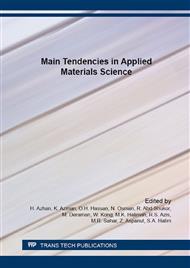[1]
P.W. McMilan, Glass-Ceramic. Harcourt Publisher LTD. (1979).
Google Scholar
[2]
W. D. Kingery, H. K. Bowen D.R. Uhlmann, Introduction to Ceramics. John Wiley & Son. (1976).
Google Scholar
[3]
T.K. Pietrzak, J.E. Garbarczyk, I. Gorzkowska, M. Wasiucionek, J.L. Nowinski, S. Gierlotka, P. Jozwiak., Correlation between electrical properties and microstructure of nanocrystallized V2O5-P2O5 glasses. Journal of Power Sources 194 (2009) 73-80.
DOI: 10.1016/j.jpowsour.2009.02.031
Google Scholar
[4]
A. Arvind, A. Sarkar, V.K. Shrikhande, A.K. Tyagi and G.P. Kothiyal, The Effect of TiO2 addition on the crystallization and phase formation in LAS glasses nucleated by P2O5. Journal of Physics and Chemistry of Solids 69 (2008) 2622-2627.
DOI: 10.1016/j.jpcs.2008.06.003
Google Scholar
[5]
X. Guo and H. Yang. Nucleation and Crystallization Behaviour of LAS system glass ceramic containing little and no Fluorine. Journal of Non-crystalline Solids 351 (2005) 2133-2137.
DOI: 10.1016/j.jnoncrysol.2005.04.071
Google Scholar
[6]
A.M. Hu, M. Li and D.L. Mao. Growth behaviour, morphology and properties of Lithium Aluminosilicate glass ceramics with different amount of CaO, MgO and TiO2 additive,. Ceramic International, 34 (2008) 1393-1397.
DOI: 10.1016/j.ceramint.2007.03.032
Google Scholar
[7]
J. Park and A. Ozturk. Effect of TiO2 addition on the crystallization and tribological properties of MgO-CaO-SiO2-P2O5-F glasses. Thermochimica Acta 470 (2008) 60-66.
DOI: 10.1016/j.tca.2008.01.018
Google Scholar
[8]
W.D. Kingrey, H.K. Bowen, D.R. Uhlmann, in: Introduction to Ceramics, 2nd ed., John Wiley, New York, (1976).
Google Scholar
[9]
X. Chen, S.S. Mao, Titanium dioxide nanomaterials: synthesis, properties, modification, and application, Chemical Reviews 107 (2007) 2891-2959.
DOI: 10.1021/cr0500535
Google Scholar
[10]
S. Ramakrishna, A. Kumar, R. Jose, K. Fujihara, J. Wang, Structural and optical properties of electrospun TiO2 nanofibres, Chemistry of Materials, 19 (2007) 6536-6542.
DOI: 10.1021/cm702601t
Google Scholar
[11]
F. Davar, Z. Fereshteh and M. Salavati-Niasari, Nanoparticles Ni and NiO: Synthesis, characterization and magnetic properties, Journal of Alloy and Compounds 476 (2009) 797-801.
DOI: 10.1016/j.jallcom.2008.09.121
Google Scholar
[12]
Jiangang Wang, Wei Chen and Lan Luo, Crystallization behaviour and microwave dielectric property of MgO-Al2O3-SiO2-TiO2-CeO2 glass ceramic. Journal of alloys and Compounds 464 (2008) 440-445.
DOI: 10.1016/j.jallcom.2007.10.011
Google Scholar
[13]
N. Latha, V. Raj, M. Selvam and P. Manisankar, Synthesis and characterization of electroless nanocrystalline Ni-P on aluminium. International Journal of Chemical Sciences, 10: 1 (2012) 479-489.
Google Scholar
[14]
B.J. Hwang, R Santhanam and D. G Liv, Journal of Power Sources, 97-98 (2001) 443.
Google Scholar


